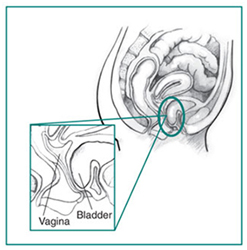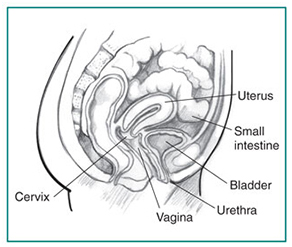This type of prolapse occurs when the strong supportive tissue or fascia normally supporting the bladder in place either stretches or tears away from its attachments on the pelvic bones. When this loss of support occurs, it allows the bladder to prolapse or fall down into the vagina.
Symptoms of Anterior Wall Prolapse
Symptoms may range – asymptomtic (no symptoms) to significant problems such as:
- Pelvic/Vaginal pressure
- Dyspareunia (painful intercourse)
- Dragging or drawing vaginal sensation
- Urinary incontinence
- Difficulty emptying bladder
- Repositioning body to empty bladder
Often as the anterior vaginal wall prolapsed worsens it progresses outside the opening of the vagina. Sometimes the bladder may not empty well which can lead to urinary frequency, nighttime voiding, loss of bladder control and recurrent bladder infections.
Anterior vaginal prolapse also affects support to the urethra, which can lead to urinary leakage with activity such as laughing, coughing, sneezing, or exercise. Anterior prolapse often occurs with prolapse of the uterus or top of the vagina where the uterus used to be in women who have had a hysterectomy.
Prevention
Non-Surgical Management
Surgical Management


